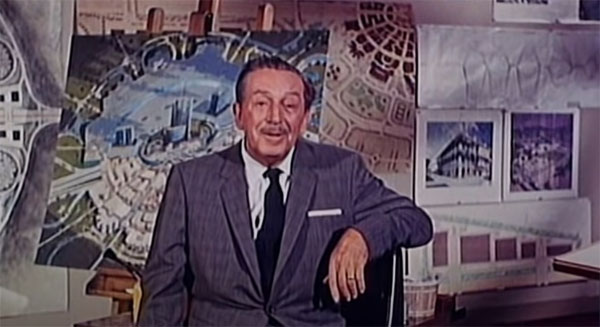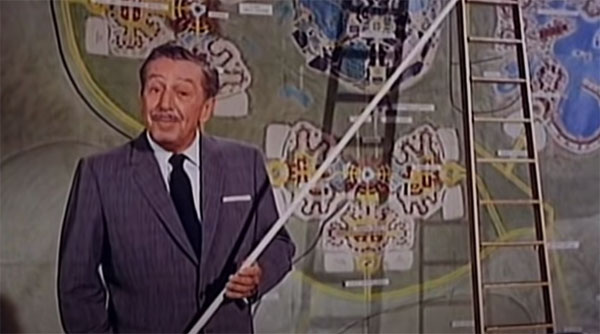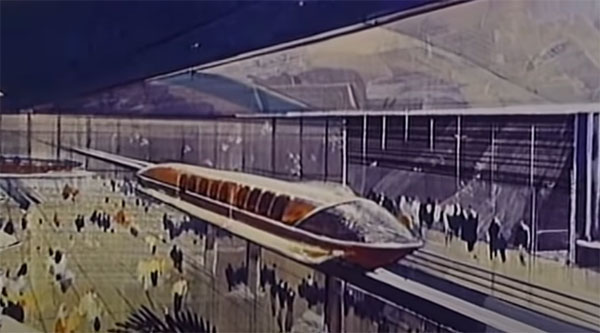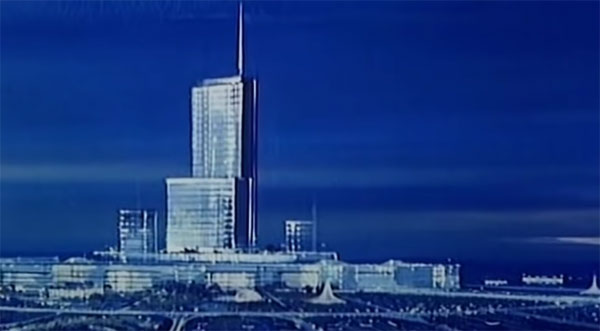
EPCOT is one of my favorite places, especially its early days. It started with a much-different concept for an Experimental Prototype Community of Tomorrow. When Walt Disney looked at the Florida project, the Magic Kingdom park that would mirror Disneyland was not a priority. Instead, his eyes were set on a new type of community where people would live and work using the latest technologies. The specifics of this plan are described in great detail by urban planner Sam Gennawey in his book Walt and the Promise of Progress City.
Another interesting aspect is the 25-minute EPCOT film that Walt recorded in October 1966. Included as part of the Tomorrowland: Disney in Space and Beyond release from the “Disney Treasures” series, it gives a fascinating look at the plans. The film begins with a six-minute prologue from an unseen narrator over shots of Disneyland and other creations. We receive a brief look at what they’ve accomplished so far, which sets the stage for Walt. He sells the importance of the Florida location, which was much different from the tourist mecca that exists today.
I love that the map for Walt Disney World includes a roller dome and ice rink right near the monorail station. There are head-scratching ideas in the plans that might seem out of place today. The resort’s size offered a chance to do basically anything, including building a futuristic airport. It’s clear from Walt’s enthusiasm that EPCOT is what’s really engaged his creativity. Standing in front of the giant map, he is visibly giddy about the project. I have caught brief clips and read many of his quotes from this film in the past, but it’s different to hear them directly from the source without editing.

Only a Hint of EPCOT’s Promise
While his excitement is high, Walt does not have the same energy. His face is pale, and he’s struggling to give a spirited presentation. He died suddenly just two months later, which was a devastating blow to the company. After Walt’s statements, drawings and animation delve into the plans. Sketches of the future are still impressive today.
The skyscraper in the middle would be a symbol of progress. An eerie factor is that the city would have been enclosed inside a dome. It would protect the citizens but might be claustrophobic. Even so, the idea of a place where pedestrians would rule intrigues me. Cars would drive beneath the city and clear up the streets.

Could Walt’s EPCOT Succeed?
Could EPCOT have worked? Skeptics claim that it would have bankrupted the Disney company. However, Walt received similar criticism when Disneyland opened in 1955. If Walt had lived to do the project, I believe he would have found a way to make it work. However, questions about voting rights and personal freedom would be a challenge. Writer Marty Sklar paints a convincing picture of how the city would work in this film, but it feels idealistic and would need compromises.
I love the idea for a city where everyone takes a PeopleMover to work, but I can only dream about it. Few would take the necessary risk to make this project succeed. It is an amazing concept but needs a risk-taking visionary to sell the material.
This promotional film makes a case for possibilities of a city like EPCOT if creators take the shot. Even Walt needed serious financing from businesses to go for his dream. His final lines that “we’re ready to go right now” have a tragic air given his imminent death and makes me wonder about missed opportunities in the years that followed.

Related Articles – The EPCOT Film
The Dream Called EPCOT and an Optimistic Future
Celebrate the Future: An EPCOT Playlist
This post contains affiliate links. Making any purchase through those links supports this site. See full disclosure.



I’ve always been fascinated by the original EPCOT concept and like most everyone else I’ve often wondered if it would have worked. After much thought, I believe that EPCOT would have ultimately failed.
If Walt had lived 5-10 more years he probably would been able to round up the partners and resources to get EPCOT built. However, the major flaw I see is the reliance on the “American industry” to grow and sustain the project. We only need to look at the EPCOT theme park for a prime example. Once the corporate sponsorships ended, pavilions such as Horizons and Wonders of Life died out. The planned industrial complexes around EPCOT’s city core would likely have sat empty once the contracts expired. In recent years we’ve seen corporate giants like General Motors teeter on the brink of economic collapse. They most likely would have pulled any “showcase” automoble production at EPCOT to cut costs.
The fuel crisis in the early 70’s would have also dealt a severe blow to EPCOT. Disney had planned to build the Asian, Venetian and Persian resorts during this time but gas shortages and economic uncertainty led them to cancel these projects. Massive cost overruns with constrution of the Contemporary and Polynesian resorts forced the company to reassess it’s future expansion plans.
As much as I would like to have seen Walt’s vision of EPCOT become reality, there’s a good chance it would have bankrupted the company. Even Roy Disney knew that the original plan for EPCOT died the moment his brother passed away.
Ron, your points make sense about the challenges that EPCOT would have faced as a city. Even if it eventually failed (or was revamped into a theme park or something else), I do think it could have had an impact on how we look at cities. I’m probably too optimistic, but it would have been fascinating to see the attempt.
Of course, the downside is that we might not have the Disney resorts that we know today if it had bankrupted the company. That’s the darkest timeline scenario of EPCOT actually happening as a city.
I grew up an EPCOT fan in the EPCOT Center era. A cultist, even. I believed in all of it.
But in the intervening years, I’ve seen the results of planned communities, and most are not great – rife with economic inequality, funding problems, and private neglect of resources that are in the public sphere elsewhere.
Walt’s plans do not well acquit themselves under scrutiny. Epcot (the city) would have been a corporate office park with some 70-era “pads” attached. Partners would have pulled out as soon as it lost money. Then the oil crisis.
Epcot (the city) lives on as a memory of an idea. It’s a great episode of Star Trek. And I’m glad it’s nothing more.
Thanks Jason. I suspect the idea would have had to evolve a lot given the economic realities of the ’70s. A lot of attractions, hotels, and more for Walt Disney World also didn’t happen for the same reason. I’m just intrigued by the concept as much as anything else. I wonder if it could have impacted what some cities do in terms of transportation. Your points about economic inequality are definitely valid; there are tons of questions on if it could have worked. If nothing else, it’s an interesting part of Disney history that’s worth considering. Sam Gennawey’s book about the idea paints an interesting picture of what it might have been if Disney tried to build it.